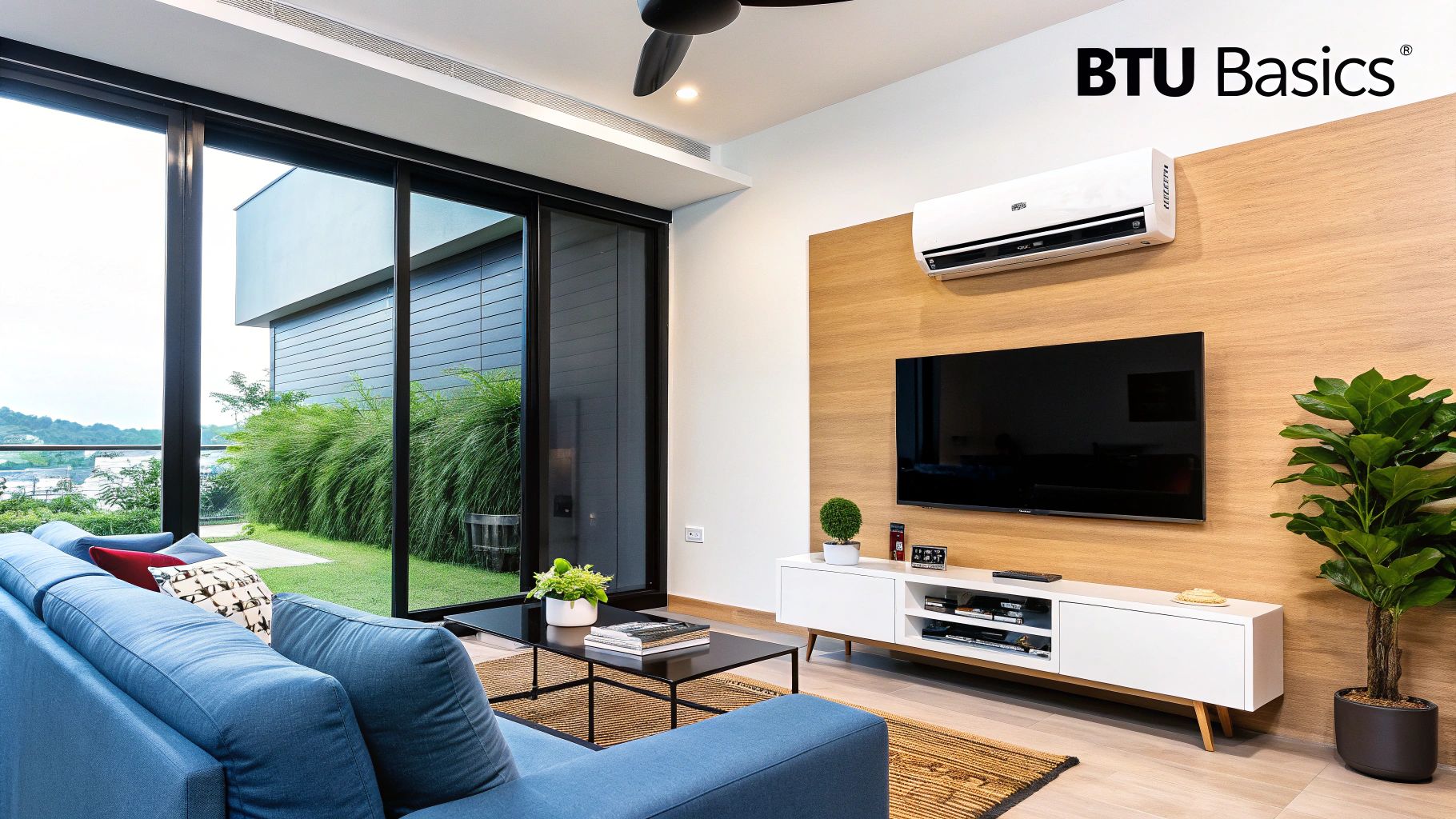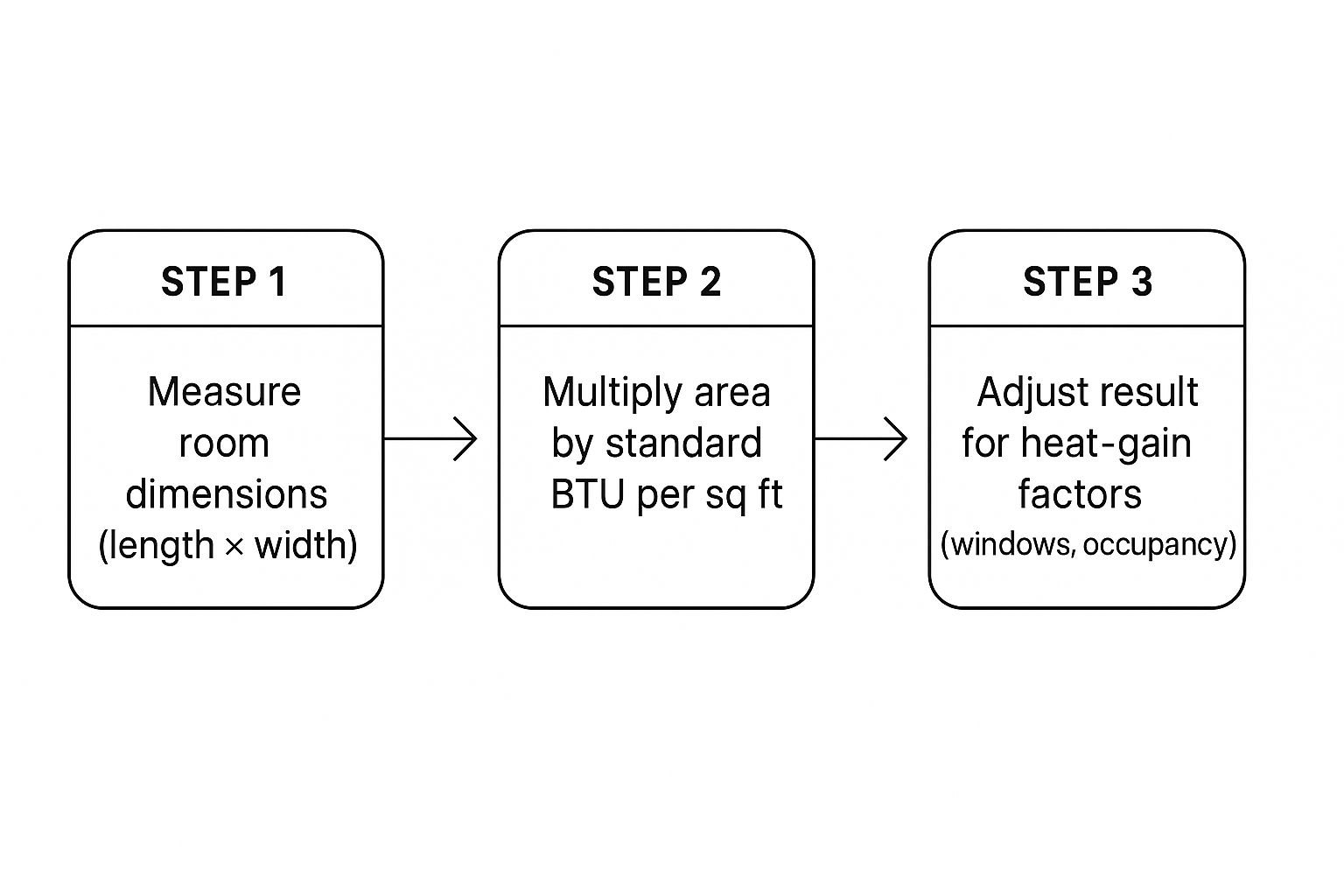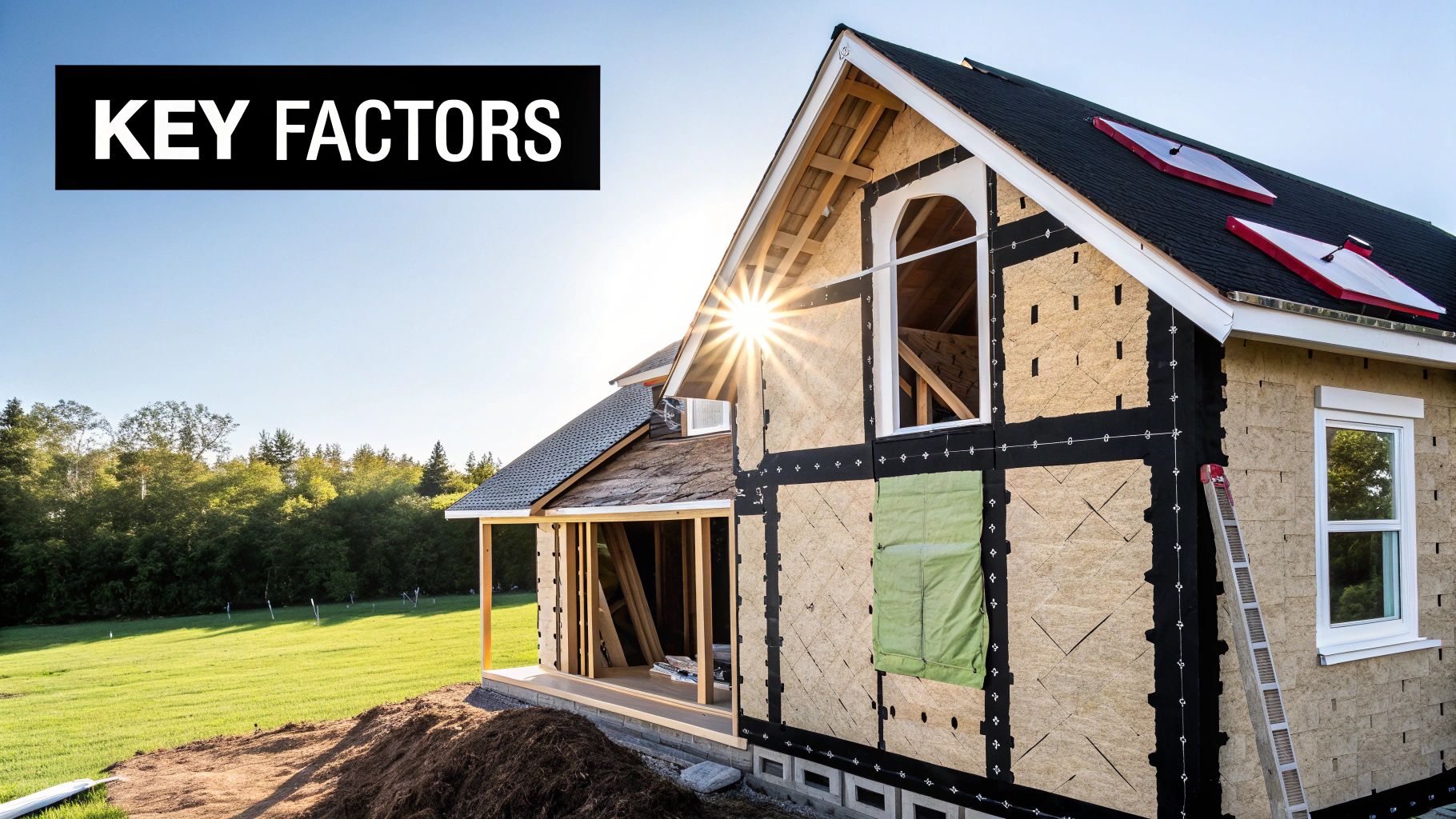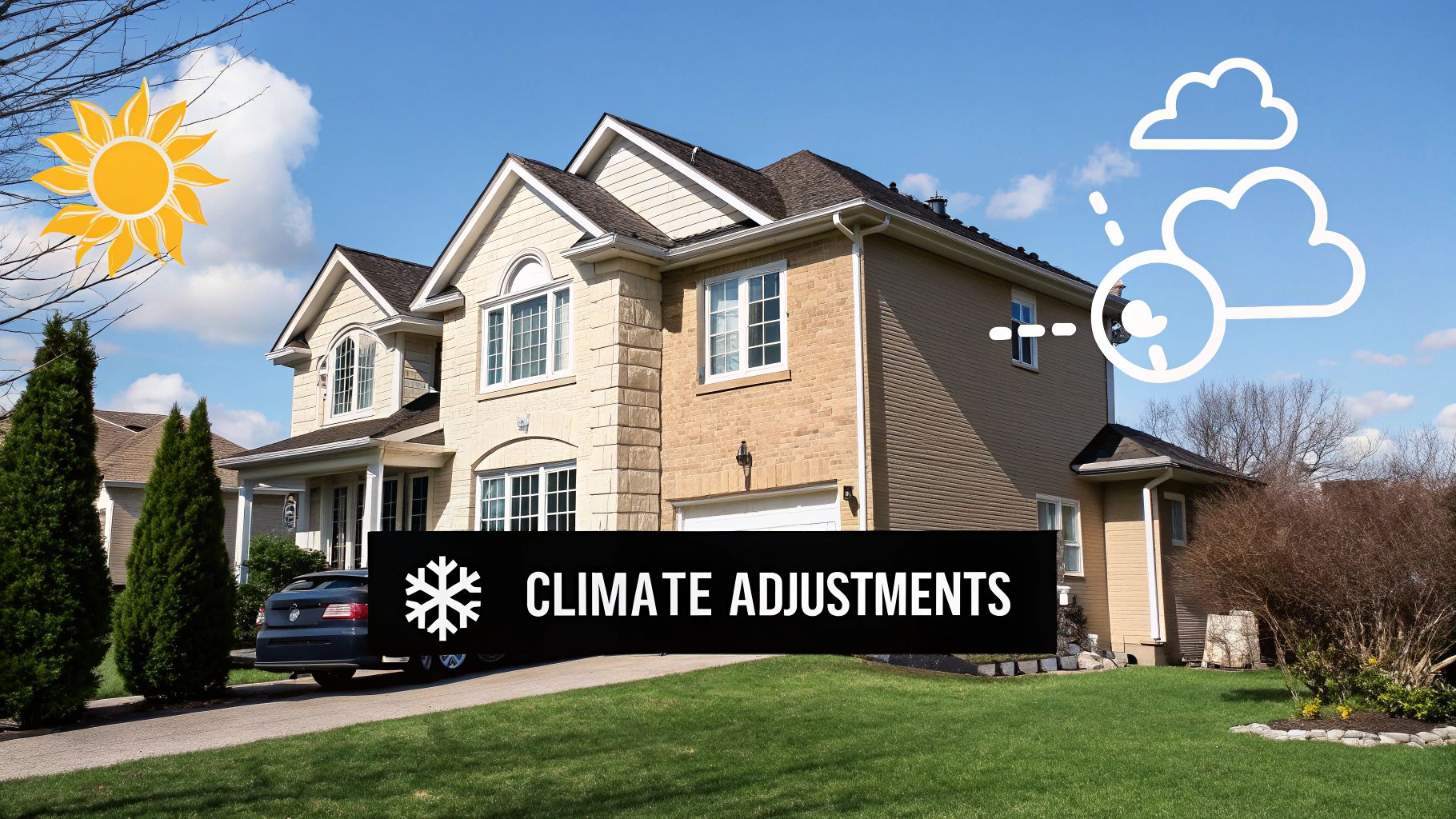Calculate BTU Per Sq Ft for Air Conditioning | Expert Guide
- shawncovenantaire
- Aug 3
- 10 min read
Updated: Aug 5
Getting your air conditioner size right is arguably the single most important factor for both your home's comfort and your monthly energy bills. If you're looking for a quick, back-of-the-napkin number, here's a solid rule of thumb: you need about 20 BTUs per square foot of living space. This is a fantastic starting point for estimating your cooling needs.
Your Guide to Air Conditioner Sizing

Choosing the right AC can feel overwhelming, but it really boils down to understanding one key term: BTU. A British Thermal Unit (BTU) is simply the standard way we measure an air conditioner's cooling power. Think of it like horsepower in a car; it's the raw strength your AC has to pull heat out of a room.
The more BTUs an AC unit has, the larger the space it can handle. Nail this number, and you'll be rewarded with both perfect comfort and a healthier wallet.
The 20 BTU Per Square Foot Rule
A long-standing guideline, backed by recommendations from the U.S. Department of Energy, is the 20 BTU per square foot rule. It's a simple and effective standard: for every square foot you want to cool, you should have 20 BTUs of cooling capacity.
So, for a 2,000-square-foot home, a quick calculation (2,000 x 20) suggests you'd need a 40,000 BTU system. It’s a reliable baseline that gets you in the right ballpark.
To make this even easier, here is a quick reference chart based on that rule:
Quick BTU Sizing Chart by Room Area
This table provides a quick reference for estimating the required cooling capacity in BTUs based on the square footage of a room, using the standard 20 BTU/sq ft rule.
This quick math gives you a solid estimate, but keep in mind, it's just the beginning of the story.
A correctly sized air conditioner is the foundation of an efficient home cooling system. It ensures your unit runs effectively, removes humidity properly, and avoids the excessive wear and tear caused by constant short cycling.
Several other factors can change the exact BTU per sq ft for air conditioning your specific home requires. Things like ceiling height, window quality, and even how sunny your rooms are can make a big difference. For a deeper dive into all the variables, check out our complete guide on how to size an air conditioner for your home. A truly accurate assessment will always look beyond just the floor plan.
Calculating Your True Cooling Needs
While the 20 BTU per square foot rule is a fantastic starting point, your home isn't just a set of dimensions on a blueprint. It has its own unique character, and getting your cooling needs right means looking beyond a simple area calculation. To truly nail the btu per sq ft for air conditioning you need, we have to dig a little deeper, just like the pros do.
Think of that basic formula as your baseline. The real magic happens when we start adjusting that number for all the little things that add heat to your space, what we in the industry call the "heat load."
The Step-by-Step Calculation Method
First things first, let's get your baseline number. This part is pretty straightforward, but it’s the foundation for everything else, so let’s get it right.
Measure Your Space: Grab a tape measure and get the length and width of the room you're looking to cool.
Calculate Square Footage: Multiply the length by the width. For a room that’s 15 feet long by 20 feet wide, your total area is 300 square feet.
Find Your Base BTUs: Now, multiply your square footage by the standard 20 BTUs. In our example, that's 300 sq. ft. x 20 BTUs = 6,000 BTUs.
This 6,000 BTU figure is our starting point. From here, we'll tweak it based on the specific factors that add extra heat to your room.
The infographic below breaks down this initial process, showing how we move from a simple measurement to a more refined number.

As you can see, getting an accurate size is more than just a single multiplication problem.
One of the first adjustments to make is for people. We all generate body heat, so you'll want to add 600 BTUs for each person (beyond the first two) who regularly uses the space.
For example, if a family of four hangs out in that 300-square-foot living room, you’d tack on an extra 1,200 BTUs (600 BTUs x 2 extra people). If the room is a kitchen, you should plan on adding another 4,000 BTUs right off the bat to handle the heat from your stove, oven, and other appliances.
These little adjustments are what separate a good guess from a truly accurate system size. To dive even deeper, check out our detailed guide on calculating HVAC size for your home.
How Your Local Climate and Sunlight Affect BTU Needs

Let's be honest: an air conditioner in scorching Phoenix has a much tougher job than one in mild Portland, Oregon. This is where a simple square footage calculation falls short. Your home's location and how much sun it gets are two of the biggest factors that influence the btu per sq ft for air conditioning you actually need.
Climate zones are central to getting this right. If you live in a hot, muggy region like the Southeast, your AC isn't just fighting heat; it's also battling relentless humidity. To keep up, you'll often need to increase your base BTU estimate by as much as 30%.
Think of it like this: your AC has two jobs in a humid climate, cooling the air and wringing moisture out of it. Doing both at once requires a lot more muscle, which means more BTUs are needed to feel comfortable.
Making this adjustment is what prevents that sticky, clammy feeling you get when an AC can't effectively dehumidify the air, even if the thermostat is set low.
Adjusting for Sun Exposure
Beyond your regional climate, the specific way sunlight hits your home plays a massive role. The amount of sun a room gets can drastically change its cooling needs, essentially creating little microclimates inside your own house.
You have to look at how much direct sun your rooms get and adjust your numbers accordingly:
Heavily Shaded Rooms: If a room is consistently shaded by trees or other buildings, you can often decrease your BTU estimate by 10%. Less direct sun means the room naturally stays cooler.
Very Sunny Rooms: For rooms that get blasted with direct sunlight, especially those with west-facing windows that soak up intense afternoon heat, you'll want to increase your BTU estimate by 10% to 20%.
For example, imagine a 500-square-foot living room with big, west-facing windows. The base calculation might suggest 10,000 BTUs. But once you factor in all that intense sun, you should add another 1,000 to 2,000 BTUs, bringing the real requirement closer to 12,000 BTUs. Ignoring this is a classic mistake that leaves you with an undersized, overworked AC that just can't keep up.
Why Your Home's Features Matter
When you start thinking about BTU per sq ft for air conditioning, you quickly realize a simple truth: not all square feet are the same. A great way to picture this is to think of your home's insulation as a high-quality thermos. Its whole job is to keep the heat out and the cool in. The quality of that thermal barrier is just as critical as the size of the room you're trying to cool.
If you have poor insulation or old, single-pane windows, they can completely sabotage your cooling efforts. They basically leave the door open for outdoor heat to seep inside, forcing your air conditioner to run much harder and longer just to keep up.
How Structure Impacts Your BTU Needs
The physical makeup of your house has a direct, and often dramatic, effect on your cooling load. Features that boost efficiency reduce the amount of work your AC has to do, which means you need fewer BTUs to stay comfortable. A home with fantastic insulation and modern, energy-efficient windows, for instance, can often get by with a surprisingly small AC unit.
On the flip side, certain architectural features can really amp up the cooling challenge. You have to account for these things:
High or Vaulted Ceilings: Most BTU calculations are based on a standard 8-foot ceiling. If you have vaulted ceilings, you've added a massive amount of air volume to the room, which can demand a 10% to 20% increase in BTUs to cool properly.
Poor Insulation: If your attic or walls are lacking good insulation, you might need to crank up your BTU estimate by as much as 30%. That's how much you'll need to compensate for the constant heat sneaking in.
Inefficient Windows: Old, drafty windows are one of the biggest culprits for heat transfer. Upgrading them is one of the single most effective ways to lower your cooling demands.
Thinking about your home's overall efficiency is key. Implementing various energy efficient home design strategies can make a huge difference in your AC's workload and your final BTU number.
It's interesting to see how things have changed. Contractors used to follow a rule of thumb: one ton of cooling for every 400 to 600 square feet. But now, with modern construction, a well-insulated, energy-efficient home often only needs one ton per 1,000 to 1,500 square feet. This drops the old 20 BTU rule down to just 8 to 12 BTUs per square foot.
Taking the time to carefully review these structural details is what makes an estimate truly accurate. And once you have your size picked out, check out our 8 essential AC installation tips for 2025 to make sure your new system delivers every bit of performance you're paying for.
The Hidden Dangers of an Oversized AC

When it comes to air conditioning, you’d think bigger is always better, right? It seems logical that a more powerful unit would cool your home faster and more effectively. In reality, choosing an AC that’s too large for your space is one of the most common, and costly, mistakes a homeowner can make.
An oversized system causes a laundry list of problems, from poor comfort to a drained bank account. The main culprit is a phenomenon called short cycling. Because the unit is too powerful, it blasts your room with frigid air, hits the thermostat's target temperature almost instantly, and then shuts right back off. This constant on-and-off cycle is incredibly inefficient and puts a ton of stress on your system.
Humidity and Comfort Problems
An air conditioner does more than just cool the air; a huge part of its job is to pull moisture out of it. This dehumidification process only kicks in when the unit runs for a sustained amount of time. Since an oversized AC shuts down so quickly, it never gets the chance to do this job properly.
The result? You end up with a room that feels cold but also damp and clammy. It’s an uncomfortable, sticky feeling, even when the thermostat says the temperature is perfect. This is why getting the btu per sq ft for air conditioning right is so important, it's about managing both temperature and humidity.
An oversized AC cools a room too fast, failing to remove humidity. This short cycling not only creates a damp, uncomfortable space but also puts extreme strain on the compressor, significantly shortening the system's lifespan.
Premature Failure and High Costs
All that starting and stopping puts immense wear and tear on the heart of your AC: the compressor. Think of it like stop-and-go city driving versus cruising on the highway; one is much harder on your car's engine. This strain is a fast track to premature system failure and eye-watering repair bills.
If your AC constantly cycles or you're dealing with humidity issues, it might be incorrectly sized. An HVAC troubleshooting guide can help you start diagnosing the problem.
On top of that, the power surge required to start the system over and over again uses a lot more electricity, which you’ll see reflected on your energy bill. Correctly sizing your AC isn't just about comfort; it's about protecting your investment. You can learn more about how to improve AC efficiency and lower bills in our other guide.
Frequently Asked Questions About AC Sizing
When you start digging into the specifics of BTU per sq ft for air conditioning, a few common questions always seem to pop up. Let's clear the air on some of the most confusing points so you can feel confident you're making the right call.
Does a Two-Story Home Need a Different Calculation?
Absolutely. A two-story home is a different beast when it comes to cooling. Since heat naturally rises, the upstairs level almost always needs more cooling power to stay as comfortable as the downstairs.
For the best results, you really need to calculate the BTU requirements for each floor separately. A pro might even suggest a zoned system, which uses multiple thermostats to give you independent control over different areas, keeping both levels perfectly comfortable.
It’s almost always better to choose an air conditioner that is slightly undersized rather than oversized. A smaller unit that runs longer is far more effective at removing humidity and experiences less wear and tear than a large unit that constantly short cycles.
How Do Kitchen Appliances Affect My BTU Calculation?
Your kitchen is a major heat factory. Think about it: the oven, stovetop, refrigerator, and dishwasher all pump heat into the room, which can really crank up the cooling load in that part of the house.
To make up for this, a good rule of thumb is to add about 4,000 BTUs to your total for a kitchen that sees regular use. This extra boost ensures your AC can keep up with the heat without breaking a sweat.
Is It Better To Round Up or Down Between Sizes?
This one trips a lot of people up. If your calculation lands you squarely between two standard AC sizes, the smarter move is almost always to round down. An oversized unit will blast your room with cold air too quickly and shut off before it has a chance to pull the humidity out, leaving you with that cold, clammy feeling.
An undersized unit, on the other hand, will just run for longer stretches. This is actually a good thing for dehumidification and is easier on the system’s components. As you make your home more efficient, you'll find that smart energy choices make a huge difference. In fact, you can learn more about how to reduce air conditioning costs with top savings tips in our related article.
Feeling confident about your cooling needs requires expert advice. At Covenant Aire Solutions, our certified technicians provide honest, upfront assessments to ensure your system is perfectly sized for your home. Get in touch with us today for a no-pressure consultation.
